by Eric Meier
When attempting to identify a wood sample, it’s important to keep in mind the limitations and obstacles that are present in our task. Before starting, please have a look at The Truth Behind Wood Identification to approach the task in a proper mindset; I consider the linked article to be required reading for all those visiting my site with the intent of identifying wood.
1. Confirm it is actually solid wood.
Before proceeding too much farther into the remaining steps, it’s first necessary to confirm that the material in question is actually a solid piece of wood, and not a man-made composite or piece of plastic made to imitate wood.
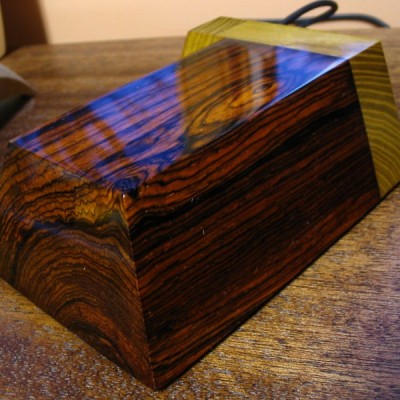
Can you see the end-grain?
Manufactured wood such as MDF, OSB, and particleboard all have a distinct look that is—in nearly all cases—easily distinguishable from the endgrain of real wood. Look for growth rings—formed by the yearly growth of a tree—which will be a dead-giveaway that the wood sample in question is a solid, genuine chunk of wood taken from a tree.
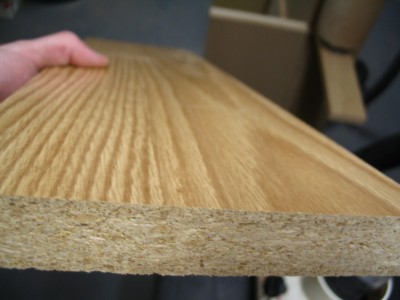
Is it veneered?
If you see a large panel that has a repeating grain pattern, it may be a veneer. In such cases, a very thin layer of real wood is peeled from a tree and attached to a substrate; sometimes the veneer can be one continuous repeating piece because it is rotary-sliced to shave off the veneer layer as the tree trunk is spun by machines. Assuming it is a real wood veneer with a distinct grain and texture—and not merely a piece of printed plastic—you may still be able to identify the outer veneer wood in question, but you should still realize that is it only a veneer and not a solid piece of wood.
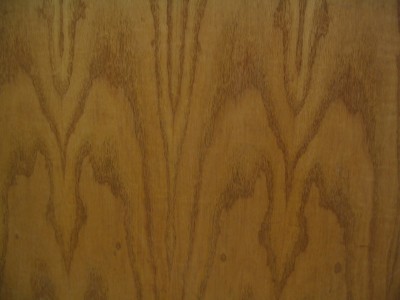
Is it painted or printed to look like wood?
Many times, especially on medium to large-sized flat panels for furniture, a piece of particleboard or MDF is either laminated with a piece of wood-colored plastic, or simply painted to look like wood grain. Many of today’s interior hardwood flooring planks are good examples of these pseudo-wood products: they are essentially a man-made material made of sawdust, glues, resins, and durable plastics.
2. Look at the color.
Some questions to immediately ask yourself:
Is the color of the wood natural, or is it stained?
If there is even a chance that the color isn’t natural, the odds are increased that the entire effort of identifying the wood will be in vain.
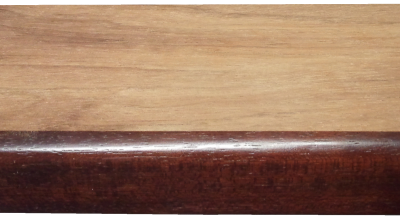
Is it weathered or have a patina?
Many woods, when left outside in the elements, tend to turn a bland gray color. Also, even interior wood also takes on a patina as it ages: some woods get darker, or redder, and some even get lighter or lose their color; but for the most part, wood tends to darken with age.
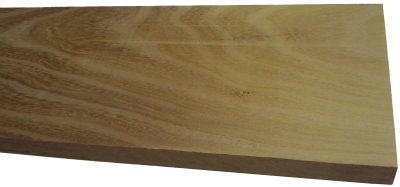
Is it possible to sand or plane the board to see the natural raw color of the wood?
The most predictable baseline to use when identifying wood is in a freshly sanded state. This eliminates the chances of a stain or natural aging skewing the color diagnosis of the wood.
3. Observe the wood grain.
If the wood is unfinished, then look at the texture of the grain. Ask yourself these questions:
Does the wood have an open, porous texture?
Most softwoods will be almost perfectly smooth with no grain indentations, while many common hardwoods have an open pore structure, such as oak or mahogany; though there are some hardwoods that are also smooth to the touch, such as maple.
Can you tell if the wood is quartersawn or plainsawn?
By observing the grain patterns, many times you can tell how the board was cut from the tree. Some wood species have dramatically different grain patterns from plainsawn to quartersawn surfaces. For instance, on their quartersawn surfaces, lacewood has large lace patterns, oak has flecks, and maple has the characteristic “butcher block” appearance.
Is there any figure or unusual characteristics, such as sapwood, curly or wild grain, burl/knots, etc.?
Some species of wood have figure that is much more common than in other species: for example, curly figure is fairly common in soft maple, and the curls are usually well-pronounced and close together. Yet when birch or cherry has a curly grain, it is more often much less pronounced, and the curls are spaced farther apart.
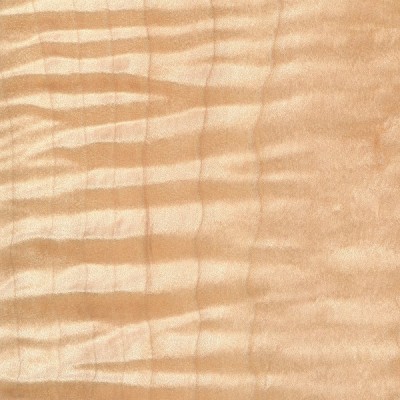
4. Consider the weight and hardness of the wood.
If it’s possible, pick the piece of wood up and get a sense of its weight, and compare it to other known wood species. Try gouging the edge with your fingernail to get a sense of its hardness. If you have a scale, you can take measurements of the length, width, and thickness of the wood, and combine them to find the density of the wood. This can be helpful to compare to other density readings found in the database. When examining the wood in question, compare it to other known wood species, and ask yourself these questions:
Is the wood dry?
Wood from freshly felled trees, or wood that has been stored in an extremely humid environment will have very high moisture contents. In some freshly sawn pieces, moisture could account for over half of the wood’s total weight! Likewise, wood that has been stored in extremely dry conditions of less than 25% relative humidity will most likely feel lighter than average.
How does the wood’s weight compare to other species?
Taking into account the size of the board, how does its weight compare to other benchmark woods? Is it heavier than oak? Is it lighter than pine? Look at the weight numbers for a few wood species that are close to yours, and get a ballpark estimate of its weight.
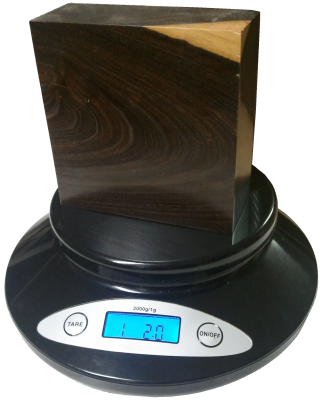
How hard is the wood?
Obviously softwoods will tend to be softer than hardwoods, but try to get a sense of how it compares to other known woods. Density and hardness are closely related, so if the wood is heavy, it will most likely be hard too. If the wood is a part of a finished item that you can’t adequately weigh, you might be able to test the hardness by gouging it in an inconspicuous area. Also, if it is used in a piece of furniture, such as a tabletop, a general idea of its hardness can be assessed by the number and depth of the gouges/dings in the piece given its age and use. A tabletop made of pine will have much deeper dents than a tabletop made of Oak. Additionally, you can always try the “fingernail test” as a rough hardness indicator: find a crisp edge of the wood, and with your fingernail try to push in as hard as you can and see if you’re able to make a dent in the wood.
5. Consider its history.
Many times we forget common sense and logic when attempting to identify wood. If you’ve got a piece of Amish furniture from Pennsylvania, chances are more likely that the wood will be made of something like black walnut or cherry, and not African wenge or jatoba. You might call it “wood profiling,” but sometimes it can pay to be a little prejudiced when it comes to wood identification. Some common-sense questions to ask yourself when trying to identify a piece of wood:
Where did it come from?
Knowing as much as you can about the source of the wood—even the smallest details—can be helpful. If the wood came from a wood pile or a lumber mill where all the pieces were from trees processed locally, then the potential species are immediately limited. If the wood came from a builder of antique furniture, or a boat-builder, or a trim carpenter: each of these occupations will tend to use certain species of woods much more often than others, making a logical guess much simpler.
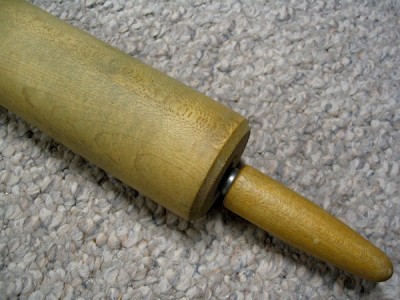
How old is it?
As with the wood’s source, its age will also help in identification purposes. Not only will it help to determine if the wood should have developed a natural patina, but it will also suggest certain species which were more prevalent at different times in history. For instance, many acoustic guitars made before the 1990s have featured Brazilian rosewood backs/sides, yet due to CITES restrictions placed upon that species, East Indian rosewood became a much more common species on newer guitars. (And this is a continuing shift as newer replacements are sought for rosewoods altogether.)
How large is the piece of wood?
Some species of trees are typically very small—some are even considered shrubs—while others get quite large. For instance, if you see a large panel or section of wood that’s entirely black, chances are it’s either painted, dyed, or stained: Gaboon ebony and related species are typically very small and very expensive.
What is the wood’s intended use?
Simply knowing what the wood was intended for—when considered in conjunction with where it came from and how old it is—can give you many clues to help identify it. In some applications, certain wood species are used much more frequently than others, so that you can make an educated guess as to the species of the wood based upon the application where it was used. For instance, in the United States: many older houses with solid hardwood floors have commonly used either red oak or hard maple; many antique furniture pieces have featured quartersawn white oak; many violins have spruce tops; many closet items used aromatic red cedar, and so forth. While it’s not a 100% guarantee, “profiling” the wood in question will help reduce the number of possible suspects, and aid in deducing the correct species.
6. Find the X-Factor.
Sometimes, after all the normal characteristics of a sample have been considered, the identity of the wood in question is still not apparent. In these instances—particularly in situations where a sample has been narrowed down to only a few possible remaining choices—it’s sometimes helpful to bring in specialized tests and other narrower means of identification.
The following techniques and recommendations don’t necessarily have a wide application in initially sorting out wood species and eliminating large swaths of wood species, but will most likely be of use only as a final step in special identification circumstances.
Odor
Believe it or not, freshly machined wood can have a very identifiable scent. When your eyes and hands can’t quite get a definitive answer, sometimes your nose can. Assuming there is no stain, finish, or preservative on or in the wood, quickly sand, saw, or otherwise machine a section of the wood in question, and take a whiff of the aroma.
Although new scents can be very difficult to express in words, many times the scent of an unknown wood may be similar to other known scents. For instance, rosewoods (Dalbergia spp.) are so named for their characteristic odor that is reminiscent of roses. Although difficult to directly communicate, with enough firsthand experience scents can become a memorable and powerful means of wood identification.
Fluorescence
While certain woods can appear basically identical to one another under normal lighting conditions, when exposed to certain wavelengths—such as those found in blacklights—the wood will absorb and emit light in a different (visible) wavelength. This phenomenon is known as fluorescence, and certain woods can be distinguished by the presence or absence of their fluorescent qualities. See the article Fluorescence: A Secret Weapon in Wood Identification for more information.
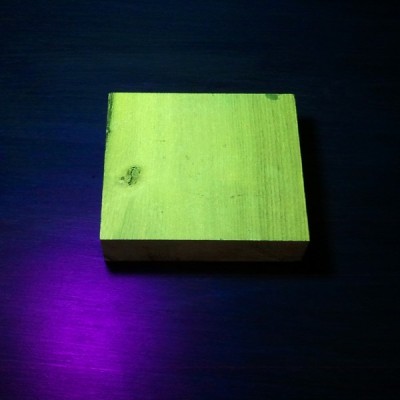
Chemical Testing
There are only a small number of chemical tests regularly used on wood, most of which are very specialized and were developed to help distinguish easily confused species with one another. They work by detecting differences in the composition of heartwood extractives. A chemical substance (called a reagent) is usually dissolved in water and applied to the wood surface: the surface is then observed for any type of chemical reaction (and accompanying color change) that may occur. Two of the most useful are the tests that are meant to separate Red and White Oak, and Red and Hard Maple.
Heartwood Extractives Leachability
Sometimes a wood species will have heartwood extractives that will be readily leachable in water and capable of conspicuously tinting a solution of water a specific color. For instance, the heartwood extractives contained in osage orange (Maclura pomifera) contain a yellowish-brown dye that is soluble in water. (This can sometimes be observed anecdotally when the wood is glued with a water-based adhesive: the glue’s squeeze-out is an unusually vibrant yellow.)
In a simple water extract color test, wood shavings are mixed with water in a vial, test tube, or other suitably small container, and the color of the water is observed after a few minutes. If the heartwood extractives are leachable by water, then a corresponding color change should quickly occur.
In addition to osage orange (Maclura pomifera), merbau (Intsia spp.), and rengas (Gluta spp. and Melanorrhoea spp.) are also noted for their readily leachable heartwood extractives. Because this property is quite uncommon, it can serve to quickly differentiate these woods from other lookalikes.
7. Look at the endgrain.
Perhaps no other technique for accurate identification of wood is as helpful and conclusive as the magnified examination of the endgrain. Frequently, it brings the identification process from a mostly intuitive, unscientific process into a predictable, repeatable, and reliable procedure.
Looking at the endgrain with a magnifier shouldn’t be a mystifying or esoteric art. In many cases, it’s nearly as simple as examining small newsprint under a magnifying glass. There are three components necessary to reap the full benefits contained in the endgrain:
I. A prepared surface.
When working with wood in most capacities, it becomes quickly apparent that endgrain surfaces are not nearly as cooperative or as easily worked as face grain surfaces. However, in this case, it is absolutely critical that a clear and refined endgrain surface is obtained.
For a quick glance of a softwood sample, a very sharp knife or razor blade can be used to take a fresh slice from the endgrain. However, in many denser species, especially in tropical hardwoods, one of the best ways to obtain a clear endgrain view is through diligent sanding. It’s usually best to begin with a relatively smooth saw cut (as from a fine-toothed miter saw blade) and proceed through the grits, starting at around 100, and working up to at least 220 or 320 grit, preferably higher for the cleanest view.
II. The right magnifier.
It need not be expensive, but whatever tool is used to view the endgrain should have adequate magnifying power. In most instances, 10x magnification is ideal, however, anything within the range of 8 to 15x magnification should be suitable for endgrain viewing. (Standard magnifying glasses are typically in the range of 2 to 4x magnification.)
These stronger magnifiers, sometimes called loupes, usually have a smaller viewing area than standard magnifying glasses. Fancier models—with built in lights, or larger viewing surfaces—are available at a premium; but the most basic models are usually only a few dollars.
III. A trained eye.
The third element that constitutes a proper endgrain examination is simply knowing what to look for. In analyzing the patterns, colors, shapes, and spacing of the various anatomical features, there is a veritable storehouse of information within the endgrain—all waiting to be unlocked. Yet, if these elements have not been pointed out and learned, the array of features will simply seem like an unintelligible jumble. The discipline of recognizing anatomical endgrain features is not easily summed up in a few sentences or even a few paragraphs, but it is nonetheless critical to the identification process. To this end, an in-depth look should be given to the various categories, divisions, and elements that constitute endgrain wood identification on the macroscopic level. (In this regard, macroscopic denotes what can be seen with a low-powered, 10x hand lens—without the aid of a microscope—rather than simply what can be seen with the naked eye.) Because the anatomy between softwoods and hardwoods is so divergent, each will be considered and examined separately:Still stumped?
If you have a mysterious piece of wood that you’d like identified, you’ve got a few options for next steps:USDA’s Forest Products Laboratory
You can mail your physical wood samples to the Center for Wood Anatomy Research.
Pros:
- Free
- Professional wood identification
Cons:
- Only available to US citizens
- Slow turnaround times (up to a month or more)
- Limited to three IDs per year
See their Wood ID Factsheet for more info.
Alden Identification Service
You can mail your physical wood samples (even small sections taken from antiques) to Alden Identification Service.
Pros:
- Professional wood identification
- Faster turnaround times (ranging from a few days to a week or two)
Cons:
- Paid service
See their ordering page for more info. (Note that Harry Alden has written several books while at USDA, including both Hardwoods and Softwoods of North America.)
Ask for help online
If the wood ID is merely a curiosity, or non-critical, you can post pictures of the wood in question.
Pros:
- Free
- No need to send physical samples
Cons:
- Greatly limited by the quality of the pictures provided
- Extra work usually required to get adequate clarity in photos
See article of Common US Hardwoods to help find the most commonly used woods.
Get the hard copy
 If you’re interested in getting all that makes The Wood Database unique distilled into a single, real-world resource, there’s the book that’s based on the website—the Amazon.com best-seller, WOOD! Identifying and Using Hundreds of Woods Worldwide. It contains many of the most popular articles found on this website, as well as hundreds of wood profiles—laid out with the same clarity and convenience of the website—packaged in a shop-friendly hardcover book.
If you’re interested in getting all that makes The Wood Database unique distilled into a single, real-world resource, there’s the book that’s based on the website—the Amazon.com best-seller, WOOD! Identifying and Using Hundreds of Woods Worldwide. It contains many of the most popular articles found on this website, as well as hundreds of wood profiles—laid out with the same clarity and convenience of the website—packaged in a shop-friendly hardcover book. 





Why I will no longer be replying to every wood ID request I’ve replied to literally thousands of wood ID requests on this site over the past 13+ years, but as the site’s popularity has grown, so has the time demands for ID on a daily basis. (Contrary to what some may seem to think, I am not some all-knowing wood wizard that can instantly ID your wood. It can actually take me a long time to sift through a lot of different resources.) Over the past few years, my backlog of pending wood species to be added to the… Read more »
Can anyone tell me what this furniture is made of. My uncle sold it to me recently. He bought at an auction. He thought it was mesquite, but I think it may be pecan. I cut a hole in the back to run wires and the wood is probably just as hard as hickory. It also kind of reminds me of a cedar elm that recently died from drought. I took a pic under one of the shelves where it wasn’t stained.

Here is the bottom and the back of the below sculpture. Thank you again. ?

Can’t tell, though it appears to have very large open pores. If I absolutely had to guess, I would venture to say it may be an Albizia species, or something related (like Monkeypod).
Thank you so much! It is pretty heavy for its size and has those two distinct colors of blonde and deeper reddish–I see that the photo looks a little like the light is causing the coloration but it’s actually that light –it’s all one piece.
That light colored wood is the sapwood, and the darker area is the heartwood. Most wood images that you will find online will generally be of the darker heartwood, so keep that in mind when comparing colors. https://www.wood-database.com/wood-articles/what-is-wood/#sap-heart
Can anyone anyone tell what kind of wood this is? No stain, I rubbed it with jojoba oil. No idea how old it is or where it was carved. Thank you ?
Hello – I need to repair some damage to the doors and door frames in my apartment and am trying to identify the type of wood. Any help is much appreciated!

Hi everyone, I have a guitar without any marks, would you be able to help identify is it a real wood, or even what kind of wood is it?
Can someone help me to identify my wood based on this photograph? I have no clue what kind of wood that I have on hand since the man sold it to me also don’t know about it.
Where are you located, and/or where did the wood come from? I would need a clear, sanded, closeup shot of the endgrain to be able to have a better chance at ID.
I’m in the process of repairing my 70 year old red oak living room floor and decided to use wood from my upstairs closet floor. i noticed that half the planks look and feel different here’s a picture to help identify
thank you
FYI wood has a strong pleasant aroma….
It may be the difference between white oak and red oak.
We bought a piece of furniture sold as “veneer over solid wood. However there are parts of it that looks like sawdust wood…. do you know if there is an overall % of veneer over solid wood for furtunure stores to advertise it as veneer over solid wood when in reality it’s only part of the whole furniture is?
Very frustrating to have the furniture at home and a closer inspection shows cheap material…
Could someone tell me this wood species thanks
Hi all, I just happened to find this site and I thank you in advance if someone can help us out. In our new home we are using Acacida wood pre stained a very very dark brown, let’s say dark chocolate color. Our problem is finding a comparable wood for our steps. We are using 4′ treads and we have 37 steps. The price we were quoted almost knocked us over. Any ideas for a coordinating wood that can be stained to compliment the dark Acacida trough out the house? We know it won’t be exact but something that would… Read more »
I bet Jatoba would look nice and is pretty hard as well. Otherwise, Ash can be stained to look like pretty much anything.
Hi, can someone help identify what kind of wood floor is this? Someone scratched it real bad, want to see if I can repair it by replacing some boards.
Thanks
trying to identify this wood. probably fron either indunasia or the philipines (most defently from the far east), one can see that for the most part this table was done by hand. can anyone tell?


That last picture strongly suggests a ring-porous hardwood. Typically this pore arrangement is usually seen in trees that grow in temperate climates.
I’m trying to identify this wood beam any help please
looks like Ovangkol, but i could be wrong!
Can anyone tell me if this looks like a laminate or veneer? It’s a dining table top. The rest of the table is solid wood and very heavy. So I’m confused on why the maker would be a laminate top on a wood table.
Thank you
Another
Here’s another pic
Another pic

Yes, it looks veneered. There are many reasons to veneer a table top. Cost, judicious use of resources, and stability (very wide boards that are solid wood tend to be less stable and more prone to warping).
Thank you. It’s definitely not solid wood. What I’m wondering is if it’s actually a plastic (or other material) laminate instead of a wood veneer. I cannot figure out what type of wood this is, if it is a veneer. It doesn’t look like any kind of wood on the wood identification pages I’ve looked at. So I wonder if it’s actually a laminate product that is printed to look like wood grain.
That’s a very real possibility. Are there any chips, gouges, or areas where the top surface has worn through at all? That will usually be the area to inspect to see if it is in fact real wood or not. (At this moment I am writing this in an office on a desk where the top is supposed to look like Black Walnut, but it is 100% fake and just printed plastic.)
I bought this old table and portions are hand planed. The swivel for drop leaf are wooden cylinders with a center dowel. The space for hinges are hand chiseled. I thought it might be oak but it’s very red.


It could be oak, but it’s hard to make out any rays anywhere, though that might be due to the stain used on the wood. More than likely oak or ash.
From what I’ve read, most Queen Anne furniture was made of Walnut then mahogany It is awfully red underneath where it is not finished. I don’t know what finished walnut looks like. But I have worked with oak and pretty sure it isn’t oak “In sophisticated urban environments, walnut was a frequent choice for furniture in the Queen Anne style,[4] superseding the previously dominant oak and leading to the era being called “the age of walnut.”[5] However, poplar, cherry, and maple were also used in Queen Anne style furniture”. I’ve attached a few more pictures. I’ve had someone from another… Read more »
Can anyone tell me what kind of wood this is based on its pattern ?
?
It looks awfully red, so I’m not sure if the color is correct, or if that’s a natural color. If it’s really that orangish red, it may be a Pterocarpus species like Padauk. But with those yellowish deposits I am seeing, that suggests something like Merbau (Intsia spp.).
Hi again! Here are some photos that may help….












Looks like it’s possible that a number of different woods have been used. Can’t tell for certain from the pictures, but some of the first pictures remind me of Pterocarpus species, such as Narra, or Muninga. This is just a guess though.
Thanks for the reply. Of the two you have suggested the Narra is the closest in stained depth of colour. Are they heavy woods?
They are relatively heavy, yes. Also of note, many Pterocapus species are under pressure from Chinese rosewood industry, so perhaps if it is a Pterocarpus species of some type, the value of the raw wood will be going up!
Hi Sir,
Could pls tell me how to determine the Narra wood in Furniture finish product pls.
Hi. I recently purchased this unusual object that I am calling a Hall Table, as that is where I am going to eventually put it. It is made from a very heavy wood, has no discernible smell, and appears to be at least 75% hand-made. The wood on the base juts out at the back by 1.5″, which makes me think it was intended to be attached to a wall or another piece of furniture, though I can’t see any nail marks on them. The lathed front corner details are grooved by hand, as is the front cupboard door detailing.… Read more »
Can anyone tell what tree these came from? I’m in Malaysia if that helps.



I’m not sure how often this page is viewed – trying to identify the attached piece of wood. One image is of the face grain, the other end grain. Any help is appreciated.

I’m looking to identify this wood. Below is a few samples after removing stain and paint. The paint was over the stain. I removed first by a heat gun and then by a chemical remover. It def wasn’t an easy task. I’m hoping the end result is worth it. Thx in advance. https
https
 ://uploads.disquscdn.com/images/8c08bdf0c37360902e7e8c7f0a8954c6198fb554f8b523171d7145bbdd490999.jpg
://uploads.disquscdn.com/images/8c08bdf0c37360902e7e8c7f0a8954c6198fb554f8b523171d7145bbdd490999.jpg
My initial guess would be Cherry, or possibly Alder.
Well then that is a good find. You think it is def a hardwood then?
Can you get a closer shot of the grain?
I would say that the legs definitely look like a hardwood to me, but can’t be sure of the rest just yet.
Very hard to tell. That looks like plywood face to me. What part of the piece is this from? There may very well be different woods used for different parts. Assuming it to be a plywood face, it could be birch, or even something like pine.
It is the table top.
https://uploads.disquscdn.com/images/08bb28d69fddc8de706f774325de0f019d71d04121
Was that good?
I would really appreciate if someone could help me identify the type of wood this cane bench was made with. It is a solid wood piece and heavy. Thanks!
I can’t really tell because it appears that that may not be the natural color of the wood. At the very least, it appears to be stained to look like walnut.
Hello everyone. I have a desk that I bought seven years ago that I am trying to sell. Not sure what kind of wood it is made of. Any insight you could provide would be appreciated.
Can anyone tell what kind of wood
Could you please identify this wood for me.



It is from a pallet that originates in Taiwan.
The second image is taken with a macro lens.
Well, I’m stumped. You should keep in mind that foreign pallet wood is about the hardest of all types of wood to ID. Not only because it is foreign (which in most cases would be enough of a challenge, especially coming from Taiwan), but because it is a pallet wood, where more obscure or lesser known species are known to pop up.
Thanks for trying Ejmeier!
I was working on a handle and I got this piece of wood from a friend and he did not know what kind of wood it was. It is a hardwood and relativity heavy/dense for its size. I was wondering if anyone hand any ideas what it might be.


Any help would be great. Thanks!
is it a monocot? looks similar to a monocot (e.g. coconut) or any forest palms we called bahi or pugahan (Caryota cumingii syn. mitis)
Is the above cedar or pine. The seller says it’s all cedar and my friend is doubting whether pine might be mixed
I am trying o figure out if the trim installed with my new windows is the same quality as the siding on my home. It looks rougher and not as nice. Admittedly, it is just primed light gray, not yet painted, but as you can see the boards are much grainier and appear to be a rougher cut then the taupe painted siding of my home. Can you tell if 1) it is cedar and 2) if the quality is the same as what is on my home (the taupe horizontal boards.) Thank you for the help



Can anyone tell me what kind of wood this is?
TIA
Can you get a closer shot of the grain? A sanded closeup endgrain shot would also help.
Can anyone please help identify this timber frame material? It was made in 1988/1978, thanks
Hi, can anyone please tell me what kind of wood this wardrobe I found is?
Any help with this. Its from Texas. The bark came off real easy and made good tender. I’m hoping it would be okay to cook with as i have a truck load of it. It’s hard wood. We spent hours chopping bits of it with an axe. Please and thank you.
Looks like American Cedar elm to me.
Possibly Douglas Fir? Hard to say for sure without getting an anlysis of the endgrain and check for resin canals.
Walnut
Anybody have an idea of what kind of wood this is? I got it with a batch of rosewood and it kinda has that smell when worked but it is certainly more brittle…great figure and sounds good too. Indian rosewood binding(trim).
Quilted maple?
Hi, I’m looking to figure out what these large, lightweight planks I have are made of. I have a few 15″ wide pieces that seem very soft, no knots or burts and a very straight grain. I have made a few picture frames out of them and want to be able to correctly identify them to potential buyers. Here is a pic with the rough sawn plank, some freshly sanded pieces, and the top one with some water on it to show the general finish color. And one picture frame with a single coat of shellac. Thanks so much for… Read more »
That looks most like Honduran Mahogany to me. This article might help: https://www.wood-database.com/wood-articles/mahogany-mixups-the-lowdown/
Thank you very much it really does look like that is it.. I appreciate the link too, lots of good info
Can anyone tell me a). if this is even wood. And b). What type
Hi, just wondering if you can help me identify what kind of wood is this board made off as well as the chess pieces. I was told it is an Antique Chess Set. When you open the draws where you store the pieces, it has a very strong wood smell.
I have a wood desk and it’s extremely heavy. I am trying to confirm the type of wood the top is. Does anybody have an idea by this photo? The dark side is stained and the other side is where I removed the stain. Thank you.
If I had to guess, I’d say it was some kiln dried walnut. Kiln drying tends to take some of the richness of color out of the walnut, and that explains the dark reddish brown stain that was used. BTW, those tiny black spots in the stained portion are from a technique known as “flyspecking” which was big in the 70s and 80s. Today most people think it’s pretty ugly — best to sand it down to raw wood if possible!
purple angel
Can anyone tell what kind of wood this might be based on the pattern shown (I already send off stain for restain)? It’s a couple pics. I think it is Kentucky Coffeetree after a week doing serch on Internet, but still not very sure.
David, that very much looks like a softwood. Coffeetree is a ring-porous hardwood, which means that you should be able to see pores arranged to make the growth rings, and I don’t see any pores in your samples. It’s much more important to focus on the anatomy rather than the overall color of the wood for ID. I would start on the page on softwood identification and look for resin canals. https://www.wood-database.com/wood-articles/softwood-anatomy/
Here is another hopeful with a picture of antique furniture! I am very curious what type of wood this wardrobe was made of (might be different types). Origin of the furniture is north of France, 1920’ies (or so I was told by the vendor, at least). I’d be very grateful to anyone knowledgeable enough to determine the wood.
Hi all! Can anyone help me identify the type of wood this old dresser is made of? Beautiful – just can’t identify.
Looks like some sort of fancy veneer, probably mahogany.
Any ideas what this wood is?
I want to say mahogany but not entirely sure.
Ihave a dresser that has laminate on one drawer that has broken off. I would like to replace the laminate on the one drawer. Would you help with what type of laminate this is?
Possibly mahogany. If you’re just going for an approximate match, mahogany will get you very close, provided you match the grain.
how can you tell if wood is Ash?
The following article would be a good place to start: https://www.wood-database.com/wood-articles/ash-wood-black-white-and-everything-in-between/
Any idea what this wood is? It’s a 25 yr old mountain dulcimer. The wood is not fragrant.
The bottom looks a whole lot like Goncalo Alves. The sides could be the same wood too, though it reminds me more of something like Koa or Australian Blackwood.
I am having an ongoing dispute with Kraftmaid Cabinet Co, I somewhat know my wood species but they are trying to pass red oakoff as hickory…….the stain color is dark but the grain and how the finish absorbed into the wood leaving pin holes tells me it is red oak. Can anyone help with identifying facts. Thank you
Do you have any pictures? Oak will have visible rays if you know how to spot them — not sure what you mean by pinholes though.
Pinholes are from the finish settling into the grains
Yes, the finish has settled into the larger earlywood pores. This is common to a number of ring porous hardwoods (including hickory). I don’t see any rays in these pictures, so I’m not sure if it’s oak. If it were oak, you should be ale to make out at least some ray fleck on rift to quartersawn areas of the wood. Maybe more pictures would help.
Possibly Sumac?
Could you please help me identify type of wood or maybe hard bamboo very heavy
Can’t tell from the pics, but it appears to be stained to imitate walnut. Almost certainly not bamboo.